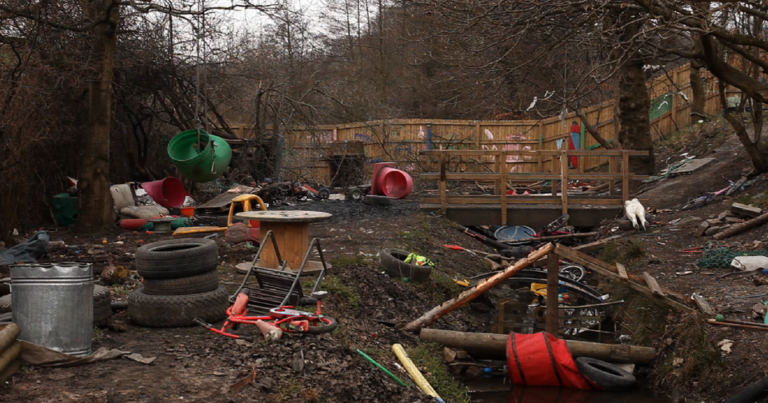“If a 10-year-old started a fire on a playground in the United States, someone would call the police and the child would be taken for counseling. At The Land, spontaneous combustion is commonplace,” writes Hannah Rosin in this month’s cover story for The Atlantic. The Land, a Welsh “adventure” playground, is radically different from standard playgrounds that emphasize safety, encouraging children to experiment with tools, junk and flammable materials.
Vermont-based filmmaker and radio producer Erin Davis recently set out to explore this phenomenon for a documentary about the land. She shares excerpts from the documentary (featuring fires, sharp objects, and gleeful children) and talks about making the film in the interview below.
The Atlantic: What sparked this project?
Erin Davis: I was lucky to have a very playful childhood in the Midwest, roaming the backyard with kids of all ages and making up our own games. Most adults I talk to have similar stories and consider it a valuable experience and a meaningful time in their lives. I’m interested in the discrepancy, on both an individual and structural level, between what we remember enjoying as children and what we tend to allow our children to do as adults.
How did you find out about this place and decide to film there?
The innovative Imagination Playground opened in Manhattan in 2010. This cool and exciting playground embraced the “loose parts” theory by filling the playspace with sand, water, and big, beautiful styrofoam blocks that kids could move around and build with. I was working closely with kids in New York City at the time, so this playground caught my eye. While reading about Imagination Playground, I was intrigued by the detail that the playground was inspired in part by “European ‘adventure’ playgrounds,” and I thought, hmm, what are those? You could say I fell down the rabbit hole.
What was it like filming it, and was there anything that surprised you during the process?
The filming was very natural and exciting. There were so many elements: fire, mud, snow, rain. The kids played outside in all sorts of conditions. The approach was observational, so we filmed the characters through risky and playful activities they initiated, with a focus on following their actions to their natural conclusion. It’s mind-blowing to witness what kids are capable of.
The kids do exactly what you’d expect: build, break, climb, swing, hide, etc. The behavior of the adult playmates on this property is truly remarkable. They don’t wear whistles around their necks or stand by and watch, they’re integrated into the space. They’re skilled and thoughtful about how and when to intervene. They take their jobs seriously, are passionate professionals, and have fun.
Why is risk play so important? Why do you think Europe is more receptive to it than the US?
In fact, this is less about “risky” play and more about child-led play. When children decide the content and direction of an activity, something may eventually emerge that adults find troubling. Supporting child-led play means giving up control and managing your own discomfort. At its core, this is a sign of deep respect for children and their experiences.
There are many factors that make adventure play difficult in America, including litigation and medical issues. Another factor is America’s obsession with measuring outcomes and rejection of activities that don’t have immediate quantifiable value, even though play has value in itself. Of course, in addition to being valuable in itself, play has been shown to improve children’s academic performance, behavior, and mental and physical health. So, ultimately, I think it’s about control and power. People who have power over others, in this case adults over children, are often hesitant to share that power.
That being said, the pendulum is swinging. The Land has peers across the US, including Pop Up Adventure Play and The Anarchy Zone. And I regularly get emails saying, “Yes! I’m trying to do this in my community too.” So there’s a hunger for change.
You raised funds on Kickstarter – did crowdsourcing the film’s budget impact your creative process?
Thanks to Kickstarter, the project started having an impact even before the film was finished. Every backer received a copy of The Playwork Primer, and many more have purchased additional copies and written me about incorporating Playwork principles into their classrooms and interactions with their children and grandchildren. This has been so gratifying.
What stage is the film at right now and when can we see it?
We’re in the editing process now, and we’re continuing to raise funds to keep up the momentum and get this story out to readers. I think people are ready for this. Parents get it, teachers get it.
What do you want audiences to take away from the film?
In the words of Mrs. Allen of Hartwood, godmother of the adventure play movement, “it’s not good enough” when it comes to play provision in the United States. We can do better. And we don’t need to reinvent the wheel.
Landscapes matter. Access to the elements – trees, water, fire – matters. Agency and authority matter. Variety and variety in play spaces matter. Land and places like it push the boundaries of what’s possible.
I also hope that this film inspires people to engage with the children in their lives in new ways — ways that are bold, thoughtful and enriching for kids and adults alike.
For more information about the film, please visit http://playfreemovie.com

